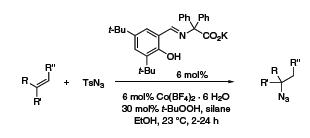Organic Azides and Azide Sources
Matthias Junkers
Since the preparation of the first organic azide, phenyl azide, by Peter Griess in 1864 this energy-rich and versatile class of compounds has enjoyed considerable interest. In more recent years, completely new perspectives have emerged, notably the use of organic azides for peptide synthesis, combinatorial synthesis, heterocycle synthesis, and the ligation or modification of biopolymers.1 The most prominent fields of application today are Huisgen 1,3-dipolar cycloadditions, and different variants of the Staudinger ligation.
The azido group can also be regarded as a protecting group for coordinating primary amines, especially in sensitive substrates like complex carbohydrates or peptidonucleic acids (PNA).2 For example, it is stable to alkene metathesis conditions.3
We are offering a broad range of organic azides for your research. Additionally a wide choice of azide sources facilitates the preparation of tailor-made organic azides.
An elegant way to produce organic azides from unactivated olefins was recently reported by Carreira and co-workers. A catalyst, that is easily prepared from Co(BF4)2 · 6H2O and a Schiff base, allows hydroazidation with p-toluenesulfonyl azide (TsN3) to yield alkyl azides. Mono-, di-, and trisubstituted olefins are tolerated in this reaction, and complete Markovnikov selectivity is observed (Scheme 1).4

Scheme 1.Organic Azides and Azide Sources
Materials
References
To continue reading please sign in or create an account.
Don't Have An Account?